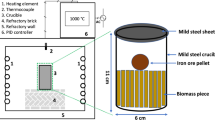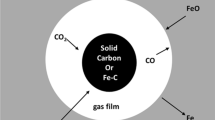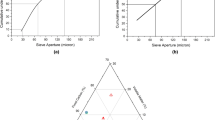Abstract
The use of biomass in different routes of ironmaking has been recently investigated. Although the volatile matter is the major constituent of the biomass, its contribution as reducing agent has not been explored in detail. This work aimed to investigate the reduction of iron ore by biomass volatiles and elucidate the steps involved, searching for optimization of its use in the ironmaking industry. Experiments with biomass and iron ore packed beds placed separately were carried out in the interval between 200 and 1000 °C in an infrared furnace. Iron ore reduction was observed at low temperatures (< 800 °C) and increased up to 1000 °C, where wustite, metallic iron and cementite were detected by XRD. Carbon deposition at low temperatures and carbothermic reduction at high temperatures were identified through carbon analysis and thermal profile measures. At low temperature the reduction occurred mainly by the non-condensable gases (CO, H2) from biomass pyrolysis and tar cracking reactions, while from 800 °C the reduction advanced by carbon deposited on the iron ore. The activation energy for the carbothermic reduction indicated the carbon gasification as the reaction-limiting step. The deposited carbon proved to be more reactive than other carbon sources commonly used in the ironmaking.
Graphical Abstract













Similar content being viewed by others
References
World Steel Association (2015) Steel’s Contribution to a Low Carbon Future and Climate Resilient Societies. World Steel Association, Brussels, pp 1–6
Ariyama T, Takahashi K, Kawashiri Y, Nouchi T (2019) Diversification of the ironmaking process toward the long-term global goal for carbon dioxide mitigation. J Sustain Metall 5:276–294. https://doi.org/10.1007/s40831-019-00219-9
Mousa E, Lundgren M, Sundqvist Ökvist L et al (2019) Reduced Carbon consumption and CO2 emission at the blast furnace by use of briquettes containing torrefied Sawdust. J Sustain Metall 5:391–401. https://doi.org/10.1007/s40831-019-00229-7
Jahanshahi S, Mathieson JG, Somerville MA et al (2015) Development of low-emission integrated steelmaking process. J Sustain Metall 1:94–114. https://doi.org/10.1007/s40831-015-0008-6
de Castro JA, de Medeiros GA, de Oliveira EM, Nogami H (2020) A comprehensive modeling as a tool for developing new mini blast furnace technologies based on biomass and hydrogen operation. J Sustain Metall 6:281–293. https://doi.org/10.1007/s40831-020-00274-7
Vassilev SV, Vassileva CG, Vassilev VS (2015) Advantages and disadvantages of composition and properties of biomass in comparison with coal: an overview. Fuel 158:330–350. https://doi.org/10.1016/j.fuel.2015.05.050
Mousa E, Wang C, Riesbeck J, Larsson M (2016) Biomass applications in iron and steel industry: an overview of challenges and opportunities. Renew Sustain Energy Rev 65:1247–1266. https://doi.org/10.1016/j.rser.2016.07.061
Ni M, Leung DYC, Leung MKH, Sumathy K (2006) An overview of hydrogen production from biomass. Fuel Process Technol 87:461–472. https://doi.org/10.1016/j.fuproc.2005.11.003
Pohlmann JG, Borrego AG, Osório E et al (2016) Combustion of eucalyptus charcoals and coals of similar volatile yields aiming at blast furnace injection in a CO2 mitigation environment. J Clean Prod 129:1–11. https://doi.org/10.1016/j.jclepro.2016.04.138
Strezov V (2006) Iron ore reduction using sawdust: experimental analysis and kinetic modelling. Renew Energy 31:1892–1905. https://doi.org/10.1016/j.renene.2005.08.032
Ueki Y, Yoshiie R, Naruse I et al (2013) Reaction behavior during heating biomass materials and iron oxide composites. Fuel 104:58–61. https://doi.org/10.1016/j.fuel.2010.09.019
Bagatini MC, Zymla V, Osório E, Vilela ACF (2017) Scale recycling through self-reducing briquettes to use in EAF. ISIJ Int 57:2081–2090. https://doi.org/10.2355/isijinternational.ISIJINT-2017-242
Konishi H, Ichikawa K, Usui T (2010) Effect of residual volatile matter on reduction of iron oxide in semi-charcoal composite pellets. ISIJ Int 50:386–389. https://doi.org/10.2355/isijinternational.50.386
EL-Tawil A, Ahmed H, EL-Geassy A, Bjorkman B (2015) Effect of Volatile Matter on Reduction of Iron Oxide- Containing Carbon Composite. 54th Annu Conf Metall (COM 2015) 1–14
Wei R, Cang D, Bai Y et al (2016) Reduction characteristics and kinetics of iron oxide by carbon in biomass. Ironmak Steelmak 43:144–152. https://doi.org/10.1179/1743281215Y.0000000061
Zhao H, Li Y, Song Q et al (2020) The rate-limiting step in the integrated coal tar decomposition and upgrading- iron ore reduction reaction determined by kinetic analysis. J Anal Appl Pyrolysis. https://doi.org/10.1016/j.jaap.2020.104808
Guo F, Liang S, Zhao X et al (2019) Catalytic reforming of biomass pyrolysis tar using the low-cost steel slag as catalyst. Energy 189:116161. https://doi.org/10.1016/j.energy.2019.116161
Iliopoulou EF, Triantafyllidis KS, Lappas AA (2019) Overview of catalytic upgrading of biomass pyrolysis vapors toward the production of fuels and high-value chemicals. Wiley Interdiscip Rev Energy Environ 8:1–29. https://doi.org/10.1002/wene.322
Kobayashi N, Itaya Y (2018) Performance of iron oxide-based oxygen carrier in iomass pyrolysis. J Chem Eng Japan 51:469–475. https://doi.org/10.1252/jcej.17we111
Luo S, Fu J (2015) Co-pyrolysis of biomass tar and iron ore fines for the production of direct reduced iron. J Renew Sustain Energy. https://doi.org/10.1063/1.4928948
Valderrama Rios ML, González AM, Lora EES, Almazán del Olmo OA (2018) Reduction of tar generated during biomass gasification: a review. Biomass Bioenerg 108:345–370. https://doi.org/10.1016/j.biombioe.2017.12.002
Nordgreen T, Nemanova V, Engvall K, Sjöström K (2012) Iron-based materials as tar depletion catalysts in biomass gasification: Dependency on oxygen potential. Fuel 95:71–78. https://doi.org/10.1016/j.fuel.2011.06.002
Cahyono RB, Yasuda N, Nomura T, Akiyama T (2014) Optimum temperatures for carbon deposition during integrated coal pyrolysis-tar decomposition over low-grade iron ore for ironmaking applications. Fuel Process Technol 119:272–277. https://doi.org/10.1016/j.fuproc.2013.11.006
Strezov V, Patterson M, Zymla V et al (2007) Fundamental aspects of biomass carbonisation. J Anal Appl Pyrolysis 79:91–100. https://doi.org/10.1016/j.jaap.2006.10.014
Strezov V, Ziolkowski A, Evans TJ, Nelson PF (2010) Assessment of evolution of Loss on Ignition matter during heating of iron ores. J Therm Anal Calorim 100:901–907. https://doi.org/10.1007/s10973-009-0398-4
Willians P, Besler S (1996) The influence of temperature and heating rate on the slow pyrolysis of biomass. Renew Energy 7:233–250
Kan T, Strezov V, Evans TJ (2016) Lignocellulosic biomass pyrolysis: a review of product properties and effects of pyrolysis parameters. Renew Sustain Energy Rev 57:1126–1140. https://doi.org/10.1016/j.rser.2015.12.185
Jouiad M, Al-Nofeli N, Khalifa N et al (2015) Characteristics of slow pyrolysis biochars produced from rhodes grass and fronds of edible date palm. J Anal Appl Pyrolysis 111:183–190. https://doi.org/10.1016/j.jaap.2014.10.024
Rodrigues J, Faix O, Pereira H (1998) Determination of lignin content of Eucalyptus globulus wood using FTIR spectroscopy. Holzforschung 52:46–50. https://doi.org/10.1515/hfsg.1998.52.1.46
Morin M, Pécate S, Hémati M, Kara Y (2016) Pyrolysis of biomass in a batch fluidized bed reactor: effect of the pyrolysis conditions and the nature of the biomass on the physicochemical properties and the reactivity of char. J Anal Appl Pyrolysis 122:511–523. https://doi.org/10.1016/j.jaap.2016.10.002
Castelein O, Soulestin B, Bonnet JP, Blanchart P (2001) The influence of heating rate on the thermal behaviour and mullite formation from a kaolin raw material. Ceram Int 27:517–522. https://doi.org/10.1016/S0272-8842(00)00110-3
Coetsee T, Pistorius PC, De Villiers EE (2002) Rate-determining steps for reduction in magnetite-coal pellets. Miner Eng 15:919–929. https://doi.org/10.1016/S0892-6875(02)00120-6
Bagatini MC, Zymla V, Osório E, Vilela ACF (2014) Carbon gasification in self-reducing mixtures. ISIJ Int 54:2687–2696. https://doi.org/10.2355/isijinternational.54.2687
He L, Hui H, Li S, Lin W (2018) Production of light aromatic hydrocarbons by catalytic cracking of coal pyrolysis vapors over natural iron ores. Fuel 216:227–232. https://doi.org/10.1016/j.fuel.2017.12.005
Acknowledgments
This work was financed in part by the Coordenação de Aperfeiçoamento de Pessoal de Nível Superior – Brasil (Capes) – Finance Code 001.
Author information
Authors and Affiliations
Corresponding author
Ethics declarations
Conflict of interest
On behalf of all authors, the corresponding author states that there is no conflict of interest.
Additional information
The contributing editor for this article was Sharif Jahanshahi.
Publisher's Note
Springer Nature remains neutral with regard to jurisdictional claims in published maps and institutional affiliations.
Rights and permissions
About this article
Cite this article
Bagatini, M.C., Kan, T., Evans, T.J. et al. Iron Ore Reduction by Biomass Volatiles. J. Sustain. Metall. 7, 215–226 (2021). https://doi.org/10.1007/s40831-021-00337-3
Received:
Accepted:
Published:
Issue Date:
DOI: https://doi.org/10.1007/s40831-021-00337-3




